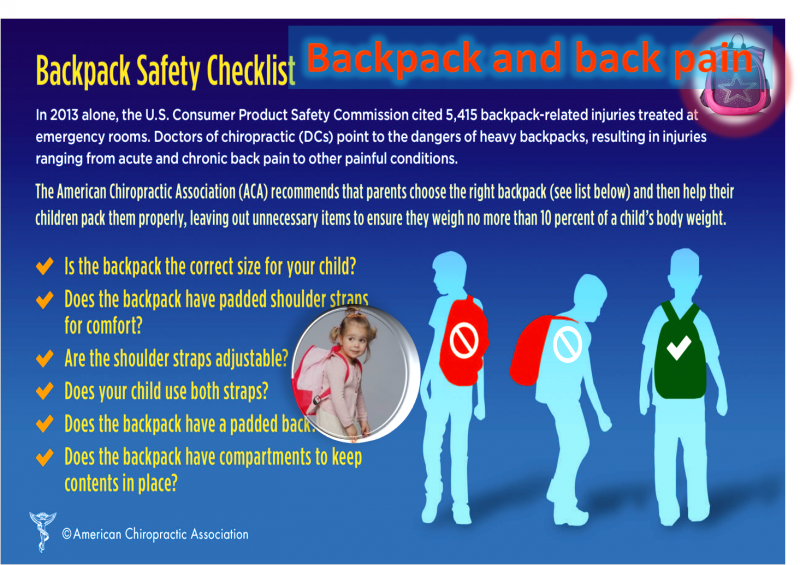
Backpack and back pain in kids
Have you ever noticed how uncomfortable the child feels to carry the backpack? Is your child complains about back pain? With all those text and notes books, homework, lunch box, water bottle the backpack of young kids becomes full and hefty. They need a proper backpack for their school. Parents must use their skills and common sense to make it easy for the child. If not, the carrying backpack can result in back pain in young children. The back will compensate for any load applied to it for an extended period of time.
A heavy weight carried in backpacks can:
- Distort the natural curves in the middle and lower backs, causing muscle strain and irritation to the spine joints and the rib cage
- Lead to rounding of the shoulders
- Cause a person to lean forward, reducing balance and making it easier to fall
- Habitually carrying backpacks over one shoulder will make muscles strain to compensate for the uneven weight. The spine leans to the opposite side, stressing the middle back, ribs, and lower back more on one side than the other does.
Research studies on backpack and back pain:
- Department of Orthopaedic Surgery at the University of California-San Diego, conducted a study on children back pain and results suggest that the high pressures exerted by a heavy backpack is the reason for the shoulder and back pain.
- In this same study, the researchers found that the usual backpack load carried by children exerts pressures that are more than acceptable levels. This condition is enough to block blood circulation.
- The researchers of Orthopaedic Department at the General Hospital of Agios Andreas Patras in Greece, in their studies found backpack carrying can result to two adverse effects: a shift in the upper trunk and shoulder, and an increase in back pain and they attributed this to Asymmetric backpack carrying.
Here are some tips for backpack selection and packing.
Backpack selection: Look for these features that help reduce the chance of back pain:
- Lightweight material (canvas as opposed to leather)
- Two padded, wide (2-inches), adjustable shoulder straps on the backpack
- Padded back
- Individualized compartments
- Hip strap, waist belt, or frame to redistribute the weight of the backpack from the shoulders and back to the pelvis
- Wheels so that the backpack can be pulled rather than carried
- Consider using a separate bag for the child’s laptop or other heavier electronic items
Teach your child how to properly load and wear the backpack to avoid back pain:
- Always use both shoulder straps and wear the backpack on the back rather than over one shoulder
- Pack heaviest objects into the backpack first so they are carried lower and closest to the body
- Fill compartments so that the load is evenly distributed throughout the backpack and items do not shift during movement
- Pack sharp or bulky objects in the backpack so they do not contact the back
- Adjust the straps to fit the backpack snugly to the child’s body, holding the bottom of the backpack 2 inches above the waist and keeping the top just below the base of the skull; do not carry the backpack low near the buttocks
- Lift the backpack by using the leg muscles and keeping it close to the body, not by bending over with arms extended
- Do not lean forward when walking; if this is necessary, there is too much weight in the backpack
Maintain a mindset to watch the weight carried in the backpack to reduce back pain:
- If the child complains of discomfort, reduce the weight in the backpack immediately and ask the child how she/he feels.
- Consider applying a guideline backpack weight limit as a percent of the child’s body weight. The American Physical Therapy Association suggests 15-20%; the American Chiropractic Association advises 5-10%.
- Coach your child to carry only those books needed in the backpack, leaving unnecessary items at home and making frequent trips to his/her locker during the day.
- Train your child to clean out the backpack at least once a week
Become a Proactive Parent on the Issue of Backpacks and Back Pain
- Ask your child if they feel any back aches or pain
- Help your child choose the smallest backpack that will meet his/her needs
- Talk to teachers about how to minimize the need for children to transport heavy books back and forth daily in their backpacks; keep one set of books in the classroom for daily work while leaving heavy books at home; make photocopies of homework chapters and assignments that are easily carried
- Attend PTA meetings and discuss any proposal by school administrators to remove lockers or to reduce time between classes making it difficult to store unneeded books and materials
- Buy ergonomic backpacks that help children to sustain asymmetric backpack weights.
Note: If the back pain does not go away and your child feels tired and fatigue then, talk to your pediatrician and understand is there any other reason for the back pain.
Read more here:
- http://www.spine-health.com/wellness/ergonomics/tips-prevent-back-pain-kids-backpacks
- Image credit: American chiropractic association https://www.acatoday.org/
Author: Sumana Rao | Posted on: January 24, 2017






















Write a comment